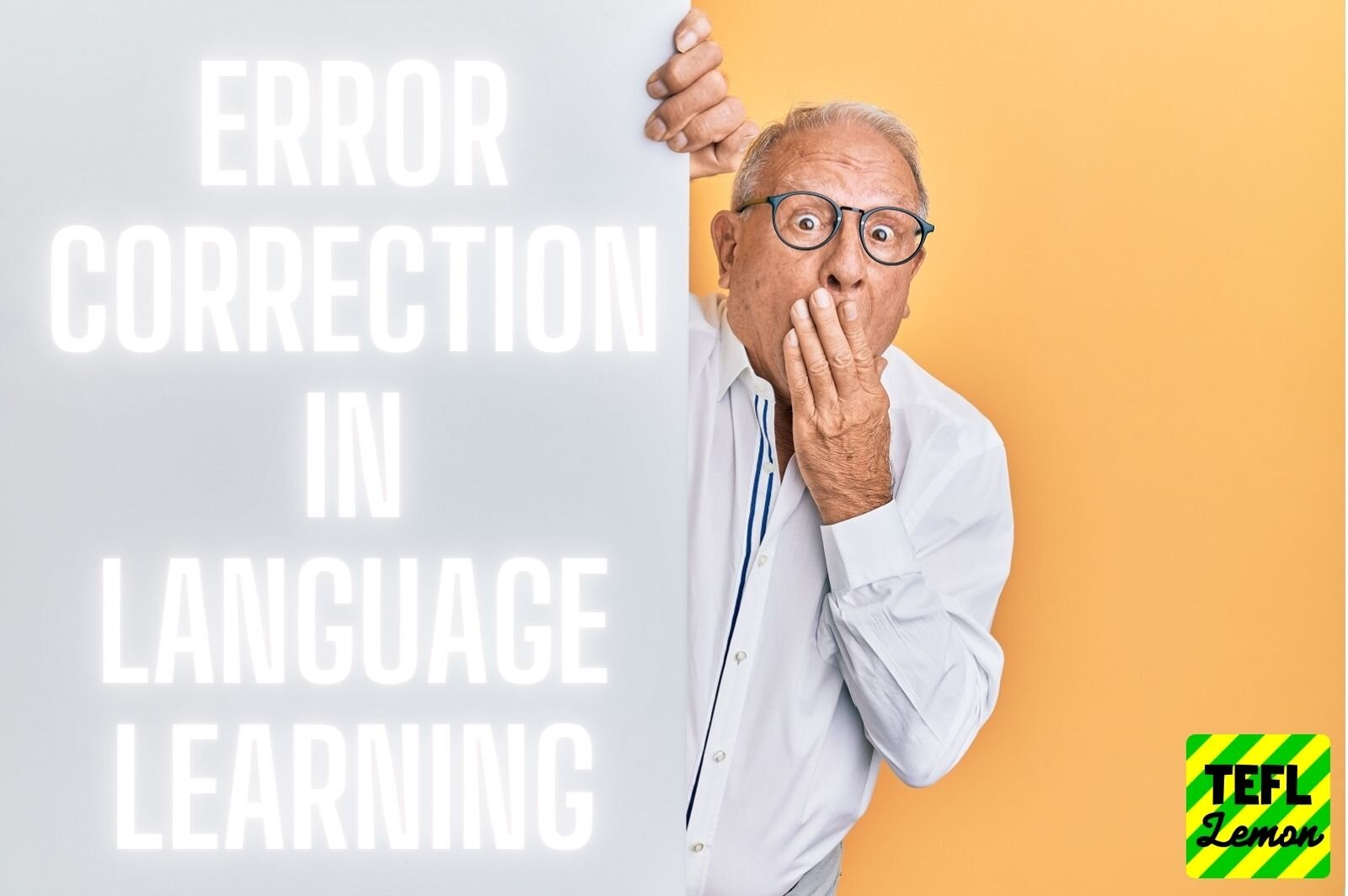Error Correction in Language Learning
Introduction
Whenever anyone learns to do something new, it is extremely rare for them to be able to perform it perfectly on their first attempt. The same must also be true with learning a new language. Children acquiring their mother tongue within the critical period will often also make errors, however, they will often naturally be corrected over time.
The Critical Period Hypothesis (CPH), was proposed by Lenneberg in 1967, which suggested the learning of a child’s first language happens naturally before the age of puberty. Although other writers disagree to an extent over where CPH is true, most people accept learning a new language after the Critical Period is over is more difficult (Newport et al 2001).
When Krashen based his “Natural Approach” (Krashen, 1983) on the CPH, he believed that errors were signs that natural development was occurring. Krashen further defined acquisition of a language, as developing language proficiency by communication, as opposed to learning which required formal teaching and error correction. Moerk, (1994) showed that even when acquiring your mother tongue correction is needed to improve. This essay will be looking into what, how and when errors should be corrected.
What should be corrected in language learning?
There is a clear need to give correction however, the impact of too much feedback can also be detrimental to student motivation (Hattie & Yates, 2013). This makes it more important to prioritise which errors to correct. When considering which errors to correct Hendrickson, (1978) suggested correction based on the student’s ability, starting with errors that affect commutation, then common errors, finally errors that will irritate. Following on from this, it is clear that you will need to correct beginners differently from advanced students. Furthermore, it is worth considering abstaining from correcting specific errors until you have introduced that area of knowledge to the students, for example, if you were correcting sentences for students trying to use the past perfect continuous when the students are still coming to grips with the simple past.
Teachers should correct mistakes based on what the students have previously learned, rather than errors they use from trying content they are as yet unready for. This is in line with Chaudron’s work (1988), which summarised students should be corrected when their error is the focus of the lesson. It is also important to correct mistakes in things previously studied, as peers hearing the mistake will question their understanding of what they’d previously learnt (Allwright,1981).
When to correct mistakes in language learning?
I will concentrate on when, to correct errors and mistakes occurring in oral speech, as written mistakes are not as time-sensitive and will be visible for much longer. The time at which you correct may depend on several factors such as what you are teaching. For example, if you happen to be teaching new vocabulary words and a student mispronounced one. You will likely correct the mistake right away, whereas if you were teaching reading fluency and a student mispronounced a word, you would probably wait until the end of the reading to correct it.
Other factors which will determine when teachers choose to correct mistakes are student confidence and class flow. Teachers should be careful not to interrupt the flow of class with excessive feedback. For example, you could share feedback with a single student after the next task has started, this will also help to reduce embarrassment. I should also mention the possibility that if errors are left uncorrected, the students will develop a habit of repeating the same mistakes. This is known as the error becoming fossilised, which will be more difficult to correct, at a later date.
How should teachers correct mistakes?
There are many ways to correct mistakes that occur in oral speech. A teacher will often use many different ways in a single lesson. I will list a few that are commonly used.
Echoing, or repeating the mistake, can be used with a questioning tone. This will give the student a chance for self-correction. Echoing is often useful if you believe the mistake was a slip. Common slips like she/he or third person can be brought to students’ attention by this method.
Gestures indicating an incorrect tense, for example, behind could mean you were expecting the past tense. Even raising your eyebrows could be a clue that something isn’t correct.
Another example I remember reading about a teacher who stuck a big “S” on a wall and pointing to it every time students forgot to use the third person. Later the "S" was removed, but they would still point to the wall. Teachers can agree on gestures with the class previously.
Repeating the sentence up until the mistake will give the student a chance to understand where in their sentence the mistake had occurred. This would again give them the opportunity to self-correct.
Using fingers again while repeating the sentence to show where a word was missing. Can be used when students miss words like “a” or “the”.
Recasting, I am not a fan of this one, as it gives students the correct answer and doesn’t give them a lot of chances to reflect on the mistake. I can see this being used for words that have been mispronounced as they should hear a good model rather than continuing to guess as to what the correct pronunciation is.
Contrast the correct and the incorrect forms, for example, “I’m loving it” or “I love it” which do you think is correct? Let’s discuss. (sorry McDonalds).
Peer-correction, if the student is unable to self-correct, maybe a peer can help correct it. This can be done by asking another student to help. This may also be achieved by allowing peers to give suggestions and let the student chose which is the correct answer.
Correcting written errors
Similarly, to correcting oral mistakes too much correction can be disheartening for students. Many teachers will use a correcting rubric this can be shared with students so that they try to correct their mistakes. Examples of such a rubric may be using “sp.” to indicate a spelling mistake. It is advantageous for students to have a chance to try to self-correct their mistakes before the teacher looks again to share the correct answers.
Tasks where students share and critique with their classmates’ work is also useful to help students become aware of their mistakes. It’s also useful to help them become more aware of different writing styles and gain ideas for their works. When giving feedback on written work it is important to understand feedback received is not the same as feedback understood. The most effective feedback is that which includes what the next step is (Hattie, 2013).
Conclusion
A lot of research has gone into what, how and when to correct, however the final decision usually lies with the teacher. Although most researchers agree that students need feedback and correction, the methods are left down to the teacher. Teachers should consider carefully when giving feedback as not to upset the flow of the class. Teachers must also be careful not to try to correct every error as too much correction can demotivate students. Teachers have many different kinds of ways to give feedback and corrections and teachers should not be afraid to use other students to suggest corrections.
by Vojtech Fiser
References citied.
Allwright, R.L., 1981. What do we want teaching materials for?. ELT journal, 36(1), pp.5-18.
Arora, S., 2015. Defossilising the errors of ESL learners through feedback. Innovation in English Language Teacher Education, 192.
Chaudron, C. (1988). Second language classrooms: Research on teaching and learning. Cambridge University Press.
Clark, E. V. ,2009. First language acquisition. Cambridge University Press.
Hattie, J., & Yates, G. C. ,2013. Visible learning and the science of how we learn. Routledge.
Hendrickson, J. M., 1978. Error correction in foreign language teaching: Recent theory, research, and practice. The modern language journal, 62(8), 387-398.
Hendrickson, J. M., 1980. The treatment of error in written work. The Modern Language Journal, 64(2), 216-221.
Hoxha, E. K., 2015. Errors in the foreign language learning process. Interdisciplinary Journal of Research and Development, 2(1), 97-100.
Ingram, D., & David, I. ,1989. First language acquisition: Method, description and explanation. Cambridge university press.
Krashen, S. D., & Krashen, S. D.,1983. Natural approach (pp. 20-20). New York: Pergamon.
Lee, I., 2003. L2 writing teachers’ perspectives, practices and problems regarding error feedback. Assessing Writing, 8(3), pp.216-237.
Lenneberg, E.H., 1967. The biological foundations of language. Hospital Practice, 2(12), pp.59-67.
Moerk, E. L., 1994. Corrections in first language acquisition: Theoretical controversies and factual evidence. International Journal of Psycholinguistics.
Newport, E.L., Bavelier, D. and Neville, H.J., 2001. Critical thinking about critical periods: Perspectives on a critical period for language acquisition. Language, brain and cognitive development: Essays in honor of Jacques Mehler, pp.481-502.
Roberts, M., 1995. Awareness and the efficacy of error correction. Attention and awareness in foreign language learning, pp.163-182.
Touchie, H. Y., 1986. Second language learning errors: Their types, causes, and treatment. JALT journal, 8(1), 75-80.
Walz, J. C. ,1982. Error Correction Techniques for the Foreign Language Classroom. Language in Education: Theory and Practice, No. 50. Center for Applied Linguistics, PO Box 4866, Hampden Station, Baltimore, MD 21211.

